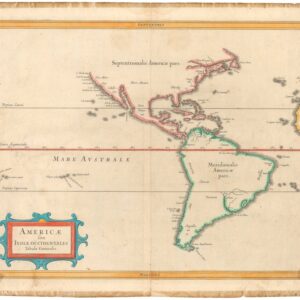The Ptolemaic world map from Hartmann Schedel’s Nüremberg Chronicle. First state.
Secunda etas mundi
Out of stock
Description
One of the earliest obtainable world maps, this iconic work was produced at a time when mankind’s horizons were constantly being expanded and challenged. Schedel endeavored to capture the world as it was understood in his time, and his map stands as one of the finest representations of the world before modern mapping.
Hartmann Schedel’s map of the world is one of the most important and iconic renditions of the world prior to the discovery and inclusion of the Americas. It was published in 1493 in Schedel’s equally iconic encyclopedia, the Liber Chronicarum, colloquially known as the Nüremberg Chronicle. Having been featured in this large scientific tome, one of the things that makes this map so special is its distinct literary feel — as if it somehow straddles the divide between printed cartography and illuminated manuscript.
The visual field is composed of three distinct elements: the map itself, a band of vignettes along the left, and a text in Latin along the bottom. The latter confirms that this is the rare first state of the map, as subsequent states have the text in German. The three elements have been physically separated and their separation visually enhanced by thin black borderlines around the two images. The visuals in Schedel’s chronicle were made as a wood-cuts, with both the map and the elongated panel of seven vignettes being printed from each their block.
The map itself was executed in the classic Ptolemaic style that was prevalent among European cartographers in the 15th century. Yet Schedel takes his work a step further by composing a geography that is completely coherent, albeit no more correct than his contemporaries. Among the features that facilitate this streamlining is the omission of both Southern Africa and Scandinavia. Even though Bartolomeu Dias had passed the Cape as early as 1488, by omitting it from the map, Schedel was able to connect Africa with a great southern continent that runs all along the bottom of the map, until it joins up with eastern Asia. In this manner, the Indian Ocean ends up being depicted as a closed maritime space, with an enormous island of Sri Lanka dominating its centre. Other classic tropes of Ptolemaic cartography include an enlarged Red Sea and a quadratic Persian Gulf, a large westward-turning Malay Peninsula that hints at the beginning of the mythical Dragon’s Tail peninsula in world maps, and African Mountains of the Moon, which feed the two large lakes that in turn supply the Nile with its life-giving waters.
The map includes many decorative features. Most noticeable are the twelve wind heads blowing from the geometric galleries framing the map. At the end of the 15th century, these wind heads were a common feature in the best Ptolemaic world maps, but only rarely do we see all twelve represented so prominently. Standing outside the framing gallery, but clearly figuring as important parts of the map’s composition, we find three figures; each of which is holding a corner of the map. Labels identify these figures as the Biblical figures of Ham, Shem, and Japhet, the three sons of Noah that left the Ark after the flood waters had subsided.
While Schedel’s map is kept in the established tradition of Ptolemaic geographies, it stands out from its peers because of the flanking panel of figures. These represent various strange and remarkable creatures inhabiting the furthest reaches of the world and reveal the fantastical mythology that still shrouded geographic observation and cartography at this stage. We find seven such scenes flanking the map, which are described by Shirley:
“A six-armed man, possibly based on a file of Hindu dancers so aligned that the front figure appears to have multiple arms; a six-fingered man, a centaur, a four-eyed man from a coastal tribe in Ethiopia; a dog-headed man from the Simien Mountains, a cyclops, one of those men whose heads grow beneath their shoulders, one of the crook-legged men who live in the desert and slide along instead of walking; a strange hermaphrodite, a man with one giant foot only (stated by Solinus to be used a parasol but more likely an unfortunate sufferer from elephantiasis), a man with a huge underlip (doubtless seen in Africa), a man with waist-length hanging ears, and other frightening and fanciful creatures of a world beyond.”
Cartographer(s):
Hartmann Schedel (1440-1514) was a physician and avid book collector whose most famous work, the Liber Chronicarum (Nüremberg Chronicle), included some of the first printed views of cities across the world.
Schedel was born in Nüremberg but was educated at both the University of Leipzig (1456-63) and the University of Padua, earning a Doctorate of medicine from the latter in 1466. The Liber Chronicarum was published in 1493. Besides this major work, one of Schedel’s most enduring legacies was his extraordinary collection of manuscripts and printed books, parts of which have been preserved in the Bayerische Staatsbibliothek in Munich.
Condition Description
Scattered wear and blemishes, but overall very nice.
References
Shirley, Rodney. (1987). The Mapping of the World. London: Holland Press, #19.





